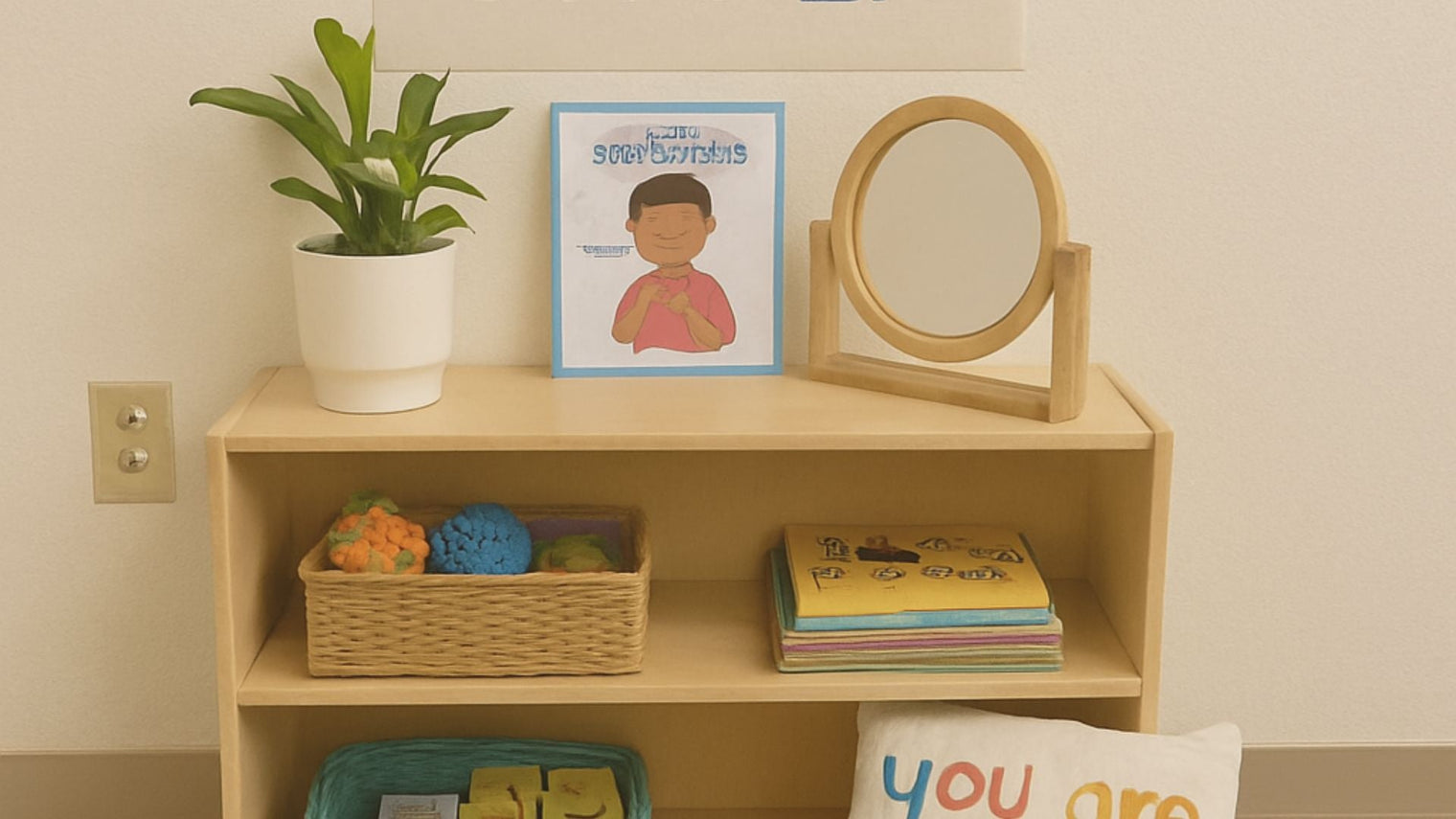Children experience big emotions every day — joy, frustration, excitement, sadness. Learning to handle those feelings in healthy ways is a key part of growing up. That’s where a Montessori peace corner comes in.
A peace corner is a calm, inviting space where children can go to reset their emotions, reflect, and regain control — all without punishment or shame. It encourages independence, emotional awareness, and empathy.
As more parents look for ways to support emotional development at home, Montessori-inspired spaces like peace corners are becoming an essential part of mindful parenting.
At Dannico Woodworks, we believe every piece of furniture in a child’s space should serve a purpose — nurturing growth, confidence, and creativity. Creating a Montessori peace corner at home does exactly that.
Let’s walk through how to design one that helps your child feel safe, calm, and in control.
Why a Peace Corner?
Children experience a wide range of emotions on a daily basis. By providing them with a peace corner, you're equipping them with a tool for self-regulation. This space encourages children to:
- Take a break when overwhelmed.
- Reflect on their feelings.
- Practice calming techniques.
- Resolve conflicts peacefully.
A peace corner empowers children by giving them the autonomy to manage their emotions constructively.
It serves as a proactive approach to emotional challenges, allowing children to step away and regroup before returning to their activities.
Over time, this practice nurtures emotional resilience, teaching children that it's okay to feel a spectrum of emotions and that they have the tools to handle them.
The peace corner, therefore, becomes a staple in their emotional education, fostering a sense of security and self-awareness.
Key Elements of a Montessori Peace Corner
When creating a Montessori peace corner, consider incorporating elements that foster tranquility and self-reflection. Below are some essential components to include:
Comfortable Seating

Ensure the seating is child-sized and easy for them to access. The tactile comfort of the seating can significantly influence a child's willingness to use the space regularly.
Moreover, the seating should be flexible enough to allow children to position themselves as they find most comfortable, promoting a sense of ownership over their personal space.
Calming Tools
Equip the peace corner with tools that help children calm down and focus. Consider including:
- Breathing exercises: Display cards with simple breathing exercises.
- Sensory bottles: These can be filled with glitter and water for a soothing visual effect.
- Fidget toys: Provide small, quiet toys that help with concentration and stress relief.
These tools are not just distractions but are carefully chosen to engage the child in self-soothing activities.
Breathing exercises can be an introduction to mindfulness, teaching children to focus on their breath and center themselves.
Sensory bottles and fidget toys cater to the sensory needs of children, providing a physical outlet for stress and anxiety.
By integrating such tools, the peace corner becomes a practical resource for emotional regulation.
Reflective Materials
Introduce items that encourage self-reflection and emotional growth:
- Mirrors: A small, unbreakable mirror allows children to observe their expressions.
- Books: Select books that focus on emotions, empathy, and conflict resolution.
- Emotion charts: Help children identify and articulate their feelings.
Reflective materials play a crucial role in helping children understand their emotions.
Mirrors can help children become more aware of their physical expressions, encouraging them to connect these expressions with their internal feelings.
Books and emotion charts serve as educational tools, providing language and context for what they are experiencing.
These elements not only support emotional literacy but also promote empathy and understanding within the child.
Nature Elements
Incorporating nature can enhance the calming effect of the peace corner:
- Plants: A small, child-friendly plant can bring a sense of peace and responsibility.
- Natural materials: Use wood, stones, or seashells as tactile elements.
Nature has an innate ability to soothe and ground us. By integrating natural elements, the peace corner can become a serene oasis that connects children with the natural world.
Plants can introduce a touch of green and life into the space, fostering a sense of responsibility as children care for them.
Natural materials like stones or seashells can serve as tactile tools, offering a physical connection to the earth that can be incredibly calming for children.
Designing Your Montessori Peace Corner
Location and Space
Select a quiet, low-traffic area in your home or classroom for the peace corner. It should be easily accessible yet slightly removed from the main activity areas. This ensures privacy and minimizes distractions.
The location should be thoughtful, balancing accessibility with a sense of seclusion.
The right spot can help maintain the peace corner's integrity as a retreat for emotional processing, away from the noise and bustle of everyday activities.
Personalization
Involve the children in setting up the peace corner. Allow them to choose some of the elements or decorations.
Personalization fosters a sense of ownership and encourages them to use the space.
When children participate in creating their peace corner, they are more likely to feel connected to it.
This personal touch can make the space more inviting and relevant to their needs, ensuring that it remains a valuable resource in their daily lives.
Simplicity and Order
Keep the peace corner simple and orderly. Avoid clutter and ensure that each item has a purpose.
A tidy space promotes relaxation and focus. Simplicity and order are fundamental in maintaining the peace corner's effectiveness.
An uncluttered space reduces overstimulation, allowing children to focus on their emotions and the calming activities available to them.
Each item's deliberate placement reinforces the corner's purpose as a place of peace and reflection.
Montessori Peace Corner Ideas
Here are some creative ideas to inspire your peace corner setup:
Themed Corners
- Nature Theme: Use natural colors and materials. Include small plants and a water feature if possible.
- Ocean Theme: Incorporate blues and greens, with ocean-related books and toys.
- Artistic Theme: Provide art supplies for children to express their emotions creatively.
Themed corners can make the peace corner more engaging and inviting for children. A nature theme can create a soothing environment that mirrors the tranquility of the outdoors.
An ocean theme can be visually calming, with its cool colors and gentle imagery.
An artistic theme allows children to express themselves through art, offering an alternative means of emotional expression.
Each theme can be tailored to the interests and needs of the children, enhancing their experience.
Seasonal Changes
Rotate items in the peace corner to reflect the seasons. This keeps the space engaging and encourages children to connect with nature's cycles.
Seasonal changes can introduce an element of novelty and excitement, keeping the peace corner fresh and relevant.
By aligning the space with the natural rhythm of the seasons, children can develop a deeper appreciation for the environment and the changes it undergoes throughout the year.
Multi-purpose Corners
Consider combining the peace corner with other Montessori principles, such as a reading nook or a sensory area.
This maximizes space and provides children with multiple resources for emotional regulation.
A multi-purpose corner can serve as a versatile space that supports various aspects of a child's development.
By integrating different Montessori elements, the corner becomes a comprehensive resource for learning and emotional growth.
Maintaining the Peace Corner
Regularly check the peace corner to ensure it remains a welcoming and effective space. Involve children in maintaining it by:
- Cleaning and organizing the area.
- Rotating items and decorations.
- Discussing what works and what doesn't.
Maintaining the peace corner is an ongoing process that benefits from active participation by the children. Involving them in upkeep teaches responsibility and reinforces their connection to the space.
Regular updates and discussions about the peace corner's effectiveness can provide valuable insights into the children's evolving needs, ensuring that the space continues to serve its purpose effectively.
Benefits of a Montessori Peace Corner
Implementing a peace corner brings numerous benefits, including:
- Improved emotional intelligence: Children learn to recognize and manage their emotions.
- Enhanced conflict resolution skills: Provides a space to think through and resolve conflicts independently.
- Increased focus and concentration: A quiet area helps children decompress and return to tasks with renewed concentration.
The peace corner acts as a cornerstone for emotional development, equipping children with the skills to navigate life's challenges.
By fostering emotional intelligence, children become more adept at understanding and articulating their feelings.
The space also promotes independence in conflict resolution, encouraging children to think critically about their interactions.
Additionally, the peace corner offers a respite from daily pressures, allowing children to recharge and refocus their energy constructively.
Common Mistakes to Avoid
- Using it as punishment: The peace corner should never be called a “time-out.”
- Over-decorating: Bright, busy decor can be overstimulating.
- Ignoring your child’s input: Let your child help choose what goes in the space. This builds ownership and pride.
Montessori Peace Corner Ideas You Can Try
- Add a small wooden shelf to hold books, calming jars, or sensory bins.
- Hang a gentle affirmation poster like “I am safe” or “I can take a deep breath.”
- Use soft natural lighting from a small lamp or window.
- Include a peace basket — a small basket with calming tools your child can carry to other rooms when needed.
Explore our Montessori Bookshelf Collection for storage solutions that help your peace corner stay organized, inviting, and accessible.
FAQs
At what age is best for a peace corner?
Children as young as two can benefit from a peace corner. Just adjust the tools to be age-appropriate — simple objects for toddlers and more reflective items for older kids.
How long should my child spend in the peace corner?
There’s no set time limit. The goal is self-regulation — your child can stay until they feel ready to rejoin activities.
Can I make a peace corner in a shared space?
Yes. Use a small shelf, rug, or curtain divider to visually mark the area as your child’s calm zone.
What if my child doesn’t want to use it?
Keep modeling it positively. Sometimes children need to see it in use before feeling comfortable going there themselves.
Final Thoughts
A Montessori peace corner is a gift of independence and emotional safety. It teaches children that emotions are part of being human — and that they have the power to manage them with kindness and confidence.
At Dannico Woodworks, we design furniture that supports these values — helping parents create spaces where children can grow, explore, and feel deeply at home.
Explore our Montessori Bookshelf Collection to find beautifully crafted pieces that make your peace corner both functional and inviting.
How will you design your child’s peace corner to reflect calm, comfort, and care?


